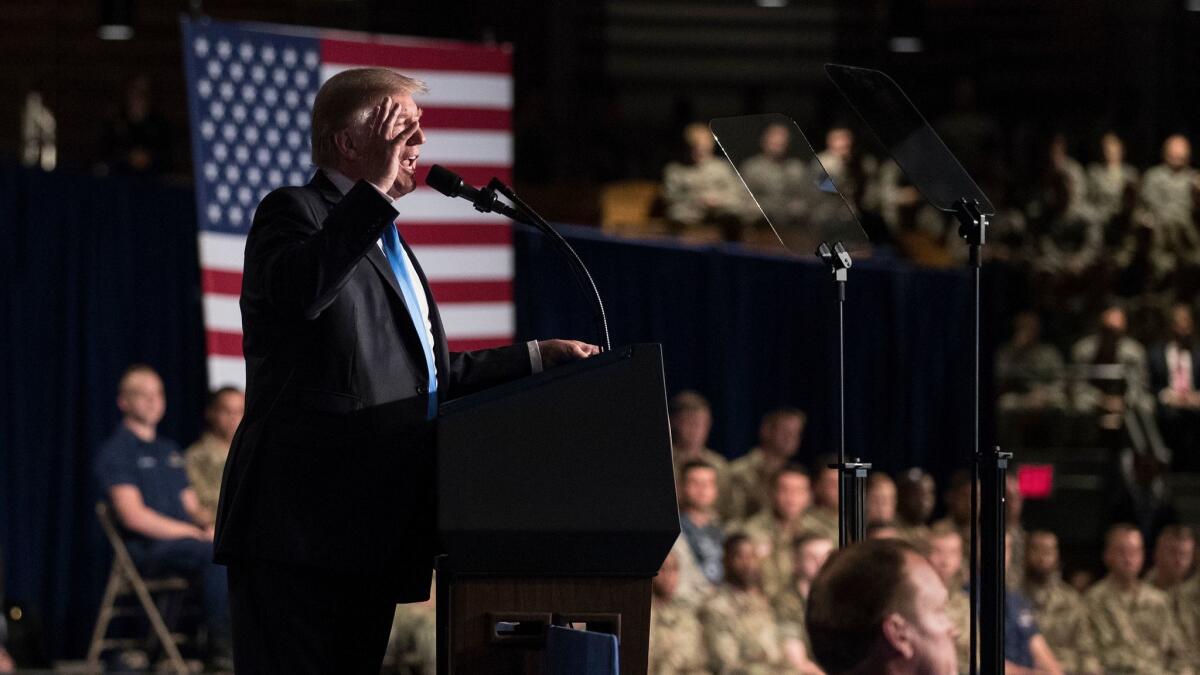Column: There is no ‘winning’ military strategy in Afghanistan

- Share via
When President Trump announced his decision to send more U.S. troops to Afghanistan this week, he described it as a bold new strategy to achieve victory in the 16-year-old war.
“In the end, we will win,” he promised. “We will always win.”
But there wasn’t much that was new about the ideas Trump outlined. If you listened closely, he wasn’t really promising to win the Afghan war, except in the limited sense of preventing the Taliban from toppling the U.S.-backed government. And the few, sketchy steps he outlined didn’t add up to a true strategy — more like a holding action aimed at staving off defeat.
And yet, for all that, it could have been worse.
Like presidents before him, Trump has discovered that foreign policy often requires choosing among bad options. The easy solutions that fill campaign speeches are rarely available in the real world.
The Trump administration hasn’t yet failed at multilateral diplomacy on Afghanistan; it has barely even tried.
Trump came into office having long argued that the United States should simply give up on its longest war. “Afghanistan is a complete waste,” he tweeted in 2012. “Time to come home!”
To his credit, once his generals explained that withdrawal would almost certainly make the country a base for Al Qaeda and Islamic State — and that he’d be blamed for the terrorists’ win — the president backed down. He gave Defense Secretary James N. Mattis more personnel, more time, more decision-making authority and a commitment (at least rhetorically) to stay as long as needed to stabilize the Kabul government.
That’s not to suggest that stability is in the cards any time soon. Trump’s aides know that 4,000 more troops won’t turn the war around. Barack Obama sent more than 100,000 troops, and that surge had disappointing results.
To turn Trump’s sketchy decision into a genuine policy, his national security team needs to succeed on three fronts, all of them challenging.
First, they need to use the new U.S. forces to bolster Afghanistan’s security forces and improve their training. That’s the most straightforward mission, one American officers have already been working on for most of a decade.
The 4,000 troops Trump is adding will bring the number of U.S. forces in Afghanistan to roughly the 13,600 that Gen. John R. Allen requested from President Obama in 2012 but didn’t get. Allen, now retired, insists that the train-and-equip program he proposed five years ago can still enable the Afghans to hold their own against the Taliban, if given enough time.
Second, they need to persuade neighboring Pakistan to stop protecting terrorist groups. That’s not a new idea, either; Presidents Obama and George W. Bush tried and failed.
“That will have to change, and that will change immediately,” Trump promised. But he didn’t say how, beyond hinting that he might cut military aid and authorize U.S. forces to attack suspected terrorists deep in Pakistani territory.
Third, U.S. diplomats need to find a way to pressure the Taliban into the peace negotiations that are the only realistic way to end the war. Indeed, the real goal of the military campaign is to make the Kabul government secure enough to negotiate successfully with the Taliban. Until now, most of the insurgents have seen little need to talk with a government that cannot defend itself unaided.
And yet, in Monday’s speech, Trump sounded almost dismissive about peace talks. “Some day, after an effective military effort, perhaps it will be possible to have a political settlement that includes elements of the Taliban in Afghanistan, but nobody knows if or when that will ever happen,” he said.
Actually, a generation’s worth of U.S. military commanders in Afghanistan have said that’s the only way out. For negotiations to succeed, however, the United States will need help not only from Pakistan, but from Iran and Russia as well. Any of the three could easily get in the way.
The Trump administration hasn’t yet failed at multilateral diplomacy on Afghanistan; it has barely even tried. The United States has no ambassador in Kabul (although a career diplomat was recently nominated). The State Department had a special office working on a regional solution to the Afghan war, but Secretary of State Rex Tillerson disbanded it last spring.
It won’t be easy to make any of the parts of the president’s scheme work. For one thing, it will require Trump to accept halfway outcomes that fall far short of the kind of total victory he likes to promise.
But there’s one factor that might make the president willing not only to stay the course in Afghanistan, but to try diplomacy as well — the same one that prompted him to reluctantly approve more troops against his initial instincts: All the alternatives look worse.
Twitter: @DoyleMcManus
Follow the Opinion section on Twitter @latimesopinion or Facebook
More to Read
A cure for the common opinion
Get thought-provoking perspectives with our weekly newsletter.
You may occasionally receive promotional content from the Los Angeles Times.










